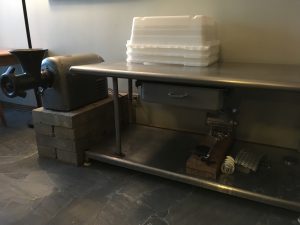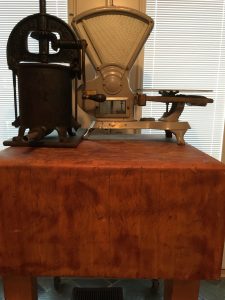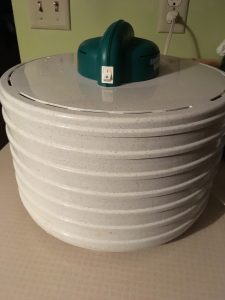Three separate acquaintances of mine recently decided to purchase electric tabletop meat grinders. I have had my home meat processing setup for many years; so was not thinking about a need to offer direction to others that might be looking to begin processing wholesale cases of pork or beef and/or wild game meat. That’s right, home meat processing equipment can be made to pay for itself year round; whether you kill something on a hunt or find comparatively inexpensive conventional meat offered at retail establishments. A moderately high capacity home freezer allows one to put-up meat into storage and thereby take economic advantage of seasonal meat price trends. I’m not going to include the cost of an independent freezer in with home meat processing equipment expenses because a freezer can also be used to preserve garden harvests and some other food items too.
The three main reasons that I home process meat are to better control the quality level of food that my family consumes, to save money on expensive protein and to have delicious precooked meat items in convenient freezer storage. While these are worthwhile rewards of home meat processing, the pitfalls can still be many and particularly for under-schooled novices. So, the goal of this post is to try and guide my fellow home meat processors into achieving a high enough economic success level that they will want to continue further processing on their own. Since you are smart, you might well be receptive to learning from some of my past mistakes.
After a meat animal is slaughtered, processing proceeds using knives first. Then knives are periodically used thereafter all the way to the dinning table. Since sharp knives are fundamental to those tasks, it’s prudent to have and to hold a tried and true brand of butcher knives. My top recommendation is Victorinox cutlery and Lemproducts.com has competitive retail prices on the recommended knife styles that they stock. If planning on skinning farm-kill or game you will need a 6 inch long skinning knife (around $30). For sticking and some boning operations buy a 6 inch straight, semi-flex boning knife (around $19). A 5 inch narrow blade, straight, stiff blade boning knives (around $19) is great for tight jobs such as neck, blade and leg bone removal. I like a 5 inch curved boning knife (around $19) for some boning operations and fatting down subcutaneous fat layers. A 10 inch carcass breaking/steak cutting knife (around $33) is also a must have. Additionally, a 10 inch Chef’s knife (around $75) is wonderful to have in one’s everyday kitchen. You will love the sharpness of your newer knives, but even new knives need to be periodically steeled to realign the cutting edge of an otherwise sharp knife. Buy a 12 or 14 inch long, fine cut F. Dick steel for around $90. longer steels lower the chance of whacking your thumb while steeling using the traditional method. To sharpen knives you may want both a 12 inch long diamond sharpening steel for about ($32) and a Norton 11 1/2 inch long three stone sharpener for around ($200). Needless to say, the items in this paragraph can realistically be a once in a lifetime purchase for an occasional home meat processor. Total dollar cost of this section is in the neighborhood of $430.
If you will be splitting carcasses, breaking down carcasses or cutting bone-in meat cuts you will also need a hand meat saw. I recommend the 25 inch long saw from Bunzl/Koch for $85.
Meat thermometers are a must-have for meat processors and cooks to monitor the receiving of raw product, precooked and table serving temperatures. I stick with 2 or 3 inexpensive, mechanically simple baby-dial thermometers; that are easy to recalibrate in either ice water or boiling water. 3 of baby-dial thermometers will run you about $25.
After sharp knives, the second biggest facilitator of home meat processing is a fast working and dependable tabletop electric meat grinder. In a more perfect world everyone could afford a $3,500 Hobart tabletop meat grinder that can rapidly and consistently knockout anything one throws at it. But, such meat grinders are cost prohibitive for most occasional users. After doing a fair amount online research to compare features and costs, I’m going to recommend a Weston Pro-series #32 tabletop meat grinder that sells for about $750. Admittedly, the soundness of this recommendation is merely an educated guess. I was blessed to be able to purchase an old used Cleveland Kleen-Kut #32 grinder 36 years ago and have never had cause to look for another meat grinder.
For boned-out meat, grinding meat into, mixing and interim product storage you will do best with 50 pound capacity truly commercial meat lugs. I recommend buying 3 of them from Bunzl/Koch Supplies for $12 a piece. Meat lugs are also handy to mix bags of nuts and some semidry fruits, to make your own trail mix. Meat lug total is around $40.

Pictured here are my grinder, stainless steel table and meat lugs. I paid a total of about $300 for all 3, a long time ago.
You should have a sanitary work table; for that I recommend going out of business small food establishment auctions. Small businesses are always going out of business everywhere so you should realistically be able to find a good deal on a stainless steel table, that is if you are patient and don’t get caught up in “auction fever.” If auctions don’t work for you, there’s always a lot of used restaurant equipment dealer around; that likely bought their inventory at auction. Plan on spending about $300 on a long, heavy gauge stainless steel food prep table.
I use a 14 1/2 by 21 inch plastic cutting board on top of my kitchen island to bone-out meat. Cost: $25.

I have owned the vintage cast iron stuffer pictured above for over 30 years and it is all I ever use. The scale is accurate and I use it sometimes. The Block is now a “for show” piece of furniture that’s on castors/cart wheels and is kept in our kitchen.
I highly recommend a stand-alone stuffer for the production of casing sausage and/or filling 1 to 1 1/2 pound ground meat chubs. A moderately high quality stuffer, with around a 15 pound capacity, will serve you well and cost about $275. Shop, compare, and read a lot of reviews. One more possibility is to find an old intact cast iron stuffer at an antique mall. I’m still able to buy stuffing horns that fit my Enterprise cast iron stuffer. Just don’t pay too much for one because it’s an antique.

This Open Country brand, small circular dehydrator will dependably handle enough volume for home usage. The round design precludes any air circulation dead-spots in corners. I keep fresh frozen blocks of jerky meat in freezer storage until I feel like making about a 4 raw pound batch. The next larger model of this pictured style of dehydrator sells for about ($60).
You could also make good use a little $50 to $100 scale. I usually take starting raw meat box or bag weight then subtract weighed trimmings from it; in order to establish starting raw meat batch weights.
A 4 ounce, stainless steel hand operated brine pump is great for getting soluble seasonings and/or other meat additives into where they can easily react with an entire roast. Most all of them that you will find are from the same manufacturer and merely have different distributor’s stickers on the tube. Lem Products sell the 4 ounce stainless steel model for $21. Sometimes my little injector will not pull a good suction, whenever that happens just open it up and run hot water on the O-ring for a short while, that always fixes the problem.
Depending upon what you are making, Pullman loaf pans with slide on lids can be a good tool to have. I sometimes cook lid-on loaves upside down on a rack in a large rectangular covered roasting pan; in order to achieve 100% humidity and while keeping cooking meat up out of cooking purge.
This year I’m adding a hand-crank meat cuber to my meat equipment repertoire; to better utilize two chuck roll muscles and to try and work some back-fat into ultra lean modern boneless pork loin chops. Minimally processed whole or half boneless pork loins currently sell for about a dollar less per pound than bone-in baby back ribs. The cuber I bought cost right at $100.
Hopefully the cuber purchase will prove to be worthwhile. Admittedly, I have mistakenly wasted money on some home meat processing equipment over the years. The equipment that I wish that I had not bought include: a hand-crank #32 meat grinder, a little enclosed knife grinder/sharpener, a manual patty press and a hand-crank meat mixer. I bought the hand-crank grinder as a backup in case my old commercial electric meat grinder ever broke down in the middle of a production run. But, unlike the hand-crank meat grinders of old, this one does not cut well at all. Next, I can still do better using a multi-cut oil stone for knife sharpening; than using the electric bevel knife grinder, plus knifes wear down slower on the oil stone. The manual patty press is almost always not worth dirtying for home quantity patty making. And, the hand crank meat mixer is more trouble that it is worth to assemble, load, unload, disassemble and clean up. However, if a side dumping mixer is not too expensive and you do enough volume at any one time, a side dumper may be worthwhile. If you want to see how I hand mix 60 pounds of ground sausage, its in this linked post (Click Here).
Equipment that I discourage you from buying: A meat slicer is not worth the purchase price and cleaning it up after use because your 10 inch knife does a good job of cutting steaks and partially frozen blocks of lean meat can be easily and effectively sliced with either a 10 or 12 inch curved butcher knife.
I don’t believe that home use vacuum sealers & pouches are economically worthwhile because packaging can still leak and because double zip-lock freezer bags are adequate for reasonably long freezer storage periods. If you want to learn more about optimal freezer storage of meat (Click Here).
Out of pocket cost for all recommended meat equipment is in the neighborhood of $2200. Supplies such as casings, spices, butcher’s twine, cure, sodium phosphate and mineral oil will add somewhat to overall meat processing costs. Mineral oil is needed to fill the reservoir of the Norton multi-cut stone sharpener and to lightly coat any non-stainless steel or non-plastic meat processing equipment that you might have. Buy mineral oil in the laxative isle of your local supermarket. These suggested practices are based solely on my home processing experiences. I welcome input of other proven home meat processing equipment or practices that anyone would care to share.

Hi
I also agree with you that grinding meat at home save our extra cost. you can do it very clean way. its makes you smart because you doing your own work.
Thanks